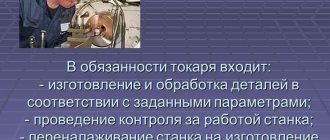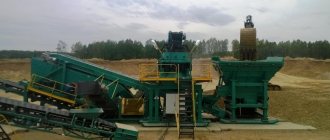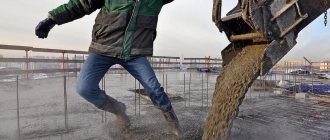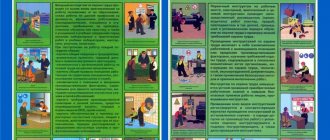General provisions
1.1. A road worker is a worker and reports directly to
_______________________________________.
(name of manager's position)
1.2. A person with secondary vocational education is hired (transferred) to work as a road worker of the 6th category.
1.3. A 2nd category road worker must know:
— types of basic road construction materials, road pavement structures and artificial structures on roads;
— methods for preparing asphalt concrete, cement concrete, bitumen-mineral and other mixtures;
— techniques for dealing with ice and snow drifts;
- Traffic Laws;
— rules for using personal protective equipment;
— requirements for the quality of work (services) performed and for the rational organization of labor in the workplace;
— range and labeling of materials used, consumption rates of fuels and lubricants;
— rules for moving and storing goods;
— types of defects and ways to prevent and eliminate them;
— production alarm;
— requirements for the quality of work in related construction processes (rules for sharpening, refueling, adjusting, setting up the tools used and using the necessary devices and measuring instruments);
— rules for reading sketches and drawings directly used in the process of work;
— requirements for the rational organization of labor in the workplace;
— the procedure for notifying the manager of all deficiencies discovered during work;
— rules for providing first (pre-medical) aid to victims of injury, poisoning and sudden illness;
— Internal labor regulations;
— rules of labor protection, industrial sanitation and personal hygiene, fire safety;
— ____________________________________________________________________.
(types, names and details of other acts and documents)
1.4. A 3rd category road worker must know:
— documents, objects, methods and techniques for performing work specified in paragraph 1.3 of these instructions;
— basic properties of road building materials;
— rules for the construction and repair of unpaved and unpaved improved roads, sidewalks and bases for asphalt concrete and cement-concrete pavements;
— rules for using power tools used in road construction and repair;
— techniques for dismantling and trimming coatings and bases using power tools;
— methods for eliminating damage and restoring road pavement;
— techniques for preparing foundations for rail forms during the construction of cement-concrete roads;
— basics of drainage installation;
— when carrying out work on marking the road surface of highways: types of road markings and rules for applying them manually, rules for performing work on roads without blocking traffic, rules for fencing workplaces during work, the main properties of paints and varnishes;
— ____________________________________________________________________.
(types, names and details of other acts and documents)
1.5. A road worker of the 4th category must know:
— documents, objects, methods and techniques for performing work specified in paragraphs 1.3 and 1.4 of these instructions;
— requirements for the quality of materials used in the construction and repair of roads;
— rules for concreting in winter and methods for heating concrete;
— rules for the construction and operation of road pavements, artificial structures and track conditions;
— when carrying out work on marking road surfaces: requirements for the quality of materials used in marking; types of horizontal and vertical markings, the order of their application; rules and techniques for applying markings with a spray gun using stencils; consumption standards for marking materials; requirements for the quality of work performed; marking rules; rules for performing work in conditions with partial closure and without closure of road traffic;
— ____________________________________________________________________.
(types, names and details of other acts and documents)
1.6. A road worker of the 5th category must know:
— documents, objects, methods and techniques for performing work specified in paragraphs 1.3 - 1.5 of these instructions;
— methods for assessing the condition of road surfaces and artificial structures;
— device and rules for using geodetic instruments;
— methods of combating soil erosion;
— ways to eliminate ice on roads;
— when carrying out work on marking road surfaces: the main types and properties of paints, solvents and thermoplastic materials, methods for determining their viscosity and fluidity; methods of applying paints and varnishes; dimensions of lines, arrows and horizontal markings; the procedure for applying markings in combination with road signs or traffic lights; technical requirements for road markings; rules for applying marking materials in combination with reflective elements; device and principle of operation of mechanized tools for applying thermoplastic materials; composition and technology for applying two-component plastic materials;
— ____________________________________________________________________.
(types, names and details of other acts and documents)
1.7. A road worker of the 6th category must know:
- documents, objects, methods and techniques for performing work specified in paragraphs 1.3 - 1.6 of these instructions;
— methods, techniques for installation and fastening of prefabricated reinforced concrete road and airfield slabs;
— methods and techniques for installing steel and cast iron plates;
— ____________________________________________________________________.
(types, names and details of other acts and documents)
1.8. A road worker of a higher level must be able to perform work that is comparable in complexity to workers of lower qualifications, as well as supervise road workers of a lower level.
1.9. ___________________________________________________________________.
§ 20. Road worker 2nd category
Characteristics of the work . Manual cleaning of bases and coverings from snow, dirt and dust. Transfer of sand, gravel and crushed stone. Watering bases and floors. Cleaning and lubricating the surface of rail molds when constructing cement-concrete pavements. Backfilling cement-concrete pavements with sand. Manual cleaning of road signs and road furnishings. Distribution of road construction materials during the construction and repair of road bases and surfaces. Cleaning the trough by hand after earthmoving machines. Darning of rail forms. Manual dismantling of bases, coverings and borders. Installation and repair of continuous turf. Manual screening of sand, gravel and crushed stone using portable screens. Manual roadside planning. Manual pouring of binders. Receiving the mixture from a dump truck with cleaning the body when constructing concrete pavements. Trimming the edges of freshly poured concrete. Manual compaction of areas inaccessible to mechanized rolling. Preparation of stone blocks and pakelage. Sorting of stone and pakkelazh.
Must know: types of basic road building materials, road pavement structures and artificial structures on roads; methods for preparing asphalt concrete, cement concrete, bitumen-mineral and other mixtures; techniques for dealing with ice and snow drifts; Traffic Laws.
Responsibilities
2.1. Before the start of the working day (shift), the road worker:
1) receives a production task;
2) if necessary, undergoes training on labor protection;
3) takes over the shift;
4) checks the serviceability of devices, tools, equipment, etc., personal protective equipment;
5) ___________________________________________________________________.
(other duties)
2.2. During the work process, the road worker:
1) performs the work for which he has been instructed and authorized to work;
2) uses special clothing, safety shoes and other personal protective equipment;
3) receives instructions from the immediate supervisor on the performance of the task, safe techniques and methods of work;
4) complies with the rules for using technological equipment, devices and tools, methods and techniques for performing work safely;
5) immediately notify the immediate supervisor of all deficiencies discovered during work;
6) complies with the requirements of personal hygiene and industrial sanitation;
7) ___________________________________________________________________.
(other duties)
2.3. During a working day (shift), a road worker:
2.3.1. 2nd category:
1) cleans the bases and coverings from snow, dirt and dust manually;
2) transfers sand, gravel and crushed stone;
3) carries out watering of bases and ceilings;
4) cleans and lubricates the surface of rail molds when constructing cement-concrete pavements;
5) backfills cement-concrete pavements with sand;
6) cleans road signs and road furnishings manually;
7) distributes road construction materials during the construction and repair of road bases and surfaces;
 cleans the trough manually after earth-moving machines;
cleans the trough manually after earth-moving machines;
9) carries out darning of rail forms;
10) dismantles bases, coverings and borders manually;
11) carries out installation and repair of continuous turf;
12) sifts sand, gravel and crushed stone manually using portable screens;
13) perform roadside planning manually;
14) pours binding materials manually;
15) receives the mixture from a dump truck with cleaning of the body when constructing concrete pavements;
16) trims the edges of the freshly laid concrete mixture;
17) manually compacts areas inaccessible to mechanized rolling;
18) produces stone block and pakkelage;
19) performs sorting of stone and package;
— ____________________________________________________________________.
(other duties)
2.3.2. 3rd category:
1) performs installation and profiling for rolling using beacons, lighthouse slats, road base templates made of sand, sand cement, gravel, crushed stone;
2) carries out profiling of unpaved and unpaved improved roads;
3) installs road signs;
4) performs installation and repair of drainages;
5) carries out patching repairs of unpaved improved roads, gravel, crushed stone surfaces, as well as repairs of unpaved roads with separate maps;
6) dismantles road surfaces and bases using mechanized tools;
7) performs installation and repair of caged turf;
 carries out the installation of foundations for laying side stones;
carries out the installation of foundations for laying side stones;
9) carries out the construction and restoration of ditches, drainage and upland ditches in compliance with longitudinal slopes and transverse profiles;
10) when carrying out work on marking road surfaces: determines control points for subsequent drawing of marking lines by machine, draws pedestrian crossing lines manually using a template;
11) installs and removes fencing devices and cones;
12) carries out work using paints and varnishes;
13) by order of the immediate supervisor, performs work that is comparable in complexity to workers of lower qualifications;
— ____________________________________________________________________.
(other duties)
2.3.3. 4th category:
1) carries out the installation and profiling of crushed stone and gravel coatings manually using beacons, beacon slats and templates;
2) carries out repairs of crushed stone and gravel surfaces using separate cards;
3) performs the final leveling of the road surface after leveling by machines;
4) installs a curb stone;
5) installs beacons and lighthouse slats;
6) carries out the installation of a preparatory layer of crushed stone or gravel under the foundations of supports and pipes;
7) removes precipitation from roads and artificial structures;
 performs finishing and repair of seam edges and surfaces of cement concrete pavements;
performs finishing and repair of seam edges and surfaces of cement concrete pavements;
9) carries out installation and maintenance of barrier and cable fencing;
10) when carrying out work on marking the road surface of highways, performs: preliminary marking of control points according to the traffic management scheme, assembly and installation of templates, application of marking material using a spray gun, demarcation of old markings, performance of work using paints and varnishes, takes part in work when marking roads with marking machines;
11) by order of the immediate supervisor, performs work that is comparable in complexity to workers of lower qualifications;
— ____________________________________________________________________.
(other duties)
2.3.4. 5th category:
1) eliminates areas of subsidence of road surfaces;
2) carries out installation and repair of pipes, trays, caps, retaining walls and parapets;
3) corrects individual damage to elements of the architectural design of highways;
4) makes a breakdown of the picketage and road elements in the plan;
5) determines the elevations of road structures using a geodetic instrument;
6) carries out installation and repair of drainages and pavings with the restoration of filters;
7) installs fencing and signaling devices;
 Performs consolidation of developing lesions;
Performs consolidation of developing lesions;
9) when carrying out work on marking the road surface of highways, performs: drawing lines of a pedestrian crossing of the “Zebra” type with paints and thermoplastic materials, marking islands separating traffic flows in opposite directions using a stencil using spray guns, drawing arrows indicating the direction of movement along stripes, two-component plastics, retroreflective elements with a pneumatic gun, marking vertical surfaces of supports, bridges, overpasses, end surfaces of portals, tunnels, parapets, work using paints and varnishes;
10) by order of the immediate supervisor, performs work that is comparable in complexity to workers of lower qualifications;
— ____________________________________________________________________.
(other duties)
2.3.5. 6th category:
1) performs installation:
— prefabricated reinforced concrete road and airfield slabs;
— steel and cast iron plates;
2) by order of the immediate supervisor, performs work that is comparable in complexity to workers of lower qualifications;
— ____________________________________________________________________.
(other duties)
2.4. At the end of the working day (shift), the road worker:
1) puts devices and tools in proper condition and transfers them for storage;
2) removes dirt from workwear and safety shoes, if necessary, places them for drying and storage;
3) performs an inspection (self-examination);
4) turns over a shift;
5) ___________________________________________________________________.
(other duties)
Sample document:
"___"__________ ____ city N ____
___________________________ (name of company)
JOB DESCRIPTION for road worker 2nd category
GENERAL PROVISIONS
1.1. This job description defines the functional responsibilities, rights and responsibilities of a road worker of the 2nd category “______” (hereinafter referred to as the “Organization”).
1.2. A road worker of the 2nd category is appointed to a position and dismissed from a position in the manner established by the current labor legislation by order of the head of the Organization.
1.3. A 2nd category road worker reports directly to ________ Organization.
1.4. A 2nd category road worker must know:
— types of basic road construction materials, road pavement structures and artificial structures on roads;
— methods for preparing asphalt concrete, cement concrete, bitumen-mineral and other mixtures;
— techniques for dealing with ice and snow drifts;
- Traffic Laws.
1.5. In his activities, a 2nd category road worker is guided by:
— regulations and methodological materials on the work performed;
— internal labor regulations;
— orders and instructions from the head of the Organization and the immediate supervisor;
— this job description;
— rules on labor protection, industrial sanitation and fire protection.
1.6. During the period of temporary absence of a 2nd category road worker, his duties are assigned to _________________.
FUNCTIONAL RESPONSIBILITIES
A road worker of the 2nd category carries out the following types of work:
Manual cleaning of bases and coverings from snow, dirt and dust.
Transfer of sand, gravel and crushed stone.
Watering bases and floors.
Cleaning and lubricating the surface of rail molds when constructing cement-concrete pavements.
Backfilling cement-concrete pavements with sand.
Manual cleaning of road signs and road furnishings.
Distribution of road construction materials during the construction and repair of road bases and surfaces.
Cleaning the trough by hand after earthmoving machines.
Manual dismantling of bases, coverings and borders.
Installation and repair of continuous turf.
Manual screening of sand, gravel and crushed stone using portable screens.
Manual roadside planning.
Manual pouring of binders.
Receiving the mixture from a dump truck with cleaning the body when constructing concrete pavements.
Trimming the edges of freshly poured concrete.
Manual compaction of areas inaccessible to mechanized rolling.
This is important to know: Is the day of dismissal a working day and is it paid: the date of dismissal in the application
Preparation of stone blocks and pakelage.
Sorting of stone and pakkelazh.
RIGHTS
A road worker of the 2nd category has the right:
3.1. Require the Organization's management to provide assistance in the performance of their duties.
3.2. Improve your skills.
3.3. Get acquainted with draft decisions of the Organization’s management relating to its activities.
3.4. Submit proposals on issues related to your activities for consideration by your immediate supervisor.
3.5. Receive from the Organization’s employees the information necessary to carry out their activities.
RESPONSIBILITY
A 2nd category road worker is responsible for:
4.1. For failure to perform or improper performance of their duties provided for in this job description - in accordance with current labor legislation.
4.2. For offenses committed during the period of its activities - in accordance with current civil, administrative and criminal legislation.
4.3. For causing material damage - in accordance with current legislation.
CONDITIONS AND PERFORMANCE EVALUATION
5.1. The working hours of a 2nd category road worker are determined in accordance with the internal labor regulations established in the Organization.
5.2. Due to production needs, a 2nd category road worker is required to go on business trips (including local ones).
Responsibility
4.1. The road worker is subject to disciplinary liability in accordance with Article 192 of the Labor Code of the Russian Federation for improper performance through his fault of the duties listed in this instruction.
4.2. The road worker bears financial responsibility for ensuring the safety of the inventory items entrusted to him.
4.3. A road worker for committing offenses in the course of his activities, depending on their nature and consequences, is brought to civil, administrative and criminal liability in the manner prescribed by law.
4.4. ___________________________________________________________________.
RIGHTS
A road worker has the right:
3.1. Familiarize yourself with management's design decisions related to its activities.
3.2. Make proposals for improving work related to the responsibilities provided for in these instructions.
3.3. Within your competence, inform your immediate supervisor about shortcomings identified in the performance of official duties and make proposals for their elimination.
3.4. Require management to provide assistance in the performance of their duties and rights.
3.5. Request personally or through your immediate supervisor information and documents necessary to perform your job duties.
3.6. Involve, with the permission of management, employees of all (individual) structural divisions in solving the tasks assigned to it.
§ 22. Road worker 4th category
Characteristics of the work . Construction and profiling of crushed stone and gravel coatings manually using beacons, lighthouse slats and templates. Repair of crushed stone and gravel surfaces with separate cards. Final planning of the road surface after leveling by machines. Installation of curb stones. Installation of beacons and lighthouse slats. Installation of a preparatory layer of crushed stone or gravel under the foundations of supports and pipes. Removal of atmospheric precipitation from roads and artificial structures. Finishing and repair of seam edges and surfaces of cement concrete pavements. Installation and maintenance of barrier and cable fencing. When carrying out work on marking the road surface of highways: preliminary marking of control points according to the traffic management scheme; assembly and installation of templates; applying marking material using a spray gun; demarcation of old markings; participation in work when marking roads with marking machines; production of work using paints and varnishes.
This is important to know: Pay index for essential workers
Must know: the requirements for the quality of materials used in the construction and repair of roads; rules for concreting in winter and methods for heating concrete; rules for the construction and operation of road pavements, artificial structures and track conditions. When carrying out work on marking the road surface of highways: the main properties of paints and varnishes; requirements for the quality of materials used for marking; types of horizontal and vertical markings, the order of their application; rules and techniques for applying markings with a spray gun using stencils; consumption standards for marking materials; requirements for the quality of work performed; marking rules; rules for performing work in conditions with partial closure and without closure of road traffic.











